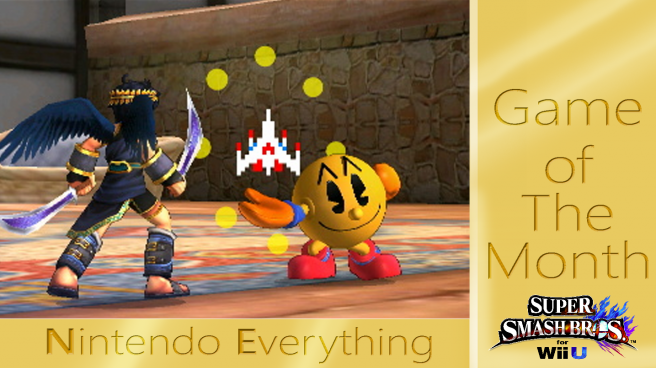[Feature] Namco Roulette: An Introduction to Pac & Pals
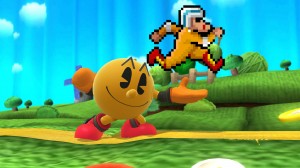
Metro Cross is one of the most memorable of Namco’s arcade games, if only for its hysterically ‘80s design sensibilities. Just look at this boxart! The game itself involves the Runner making a frantic dash to the finish line before time runs out and he faces a brutal electrocution. Everything from tires to pitfalls to mice stand in the Runner’s way, but he can gain a nice speed boost by catching a ride on a skateboard. Kids, follow his example and keep your helmet on when skateboarding. The Runner also collects cans of soda during his sprint, making this a spiritual prequel to Pepsiman. There’s a medley of Metro-Cross music that plays on the Pac-Land stage in Super Smash Bros., though you might be more familiar with it from Noby Noby Boy.

Nintendo equivalent: Captain Falcon – The Runner and good ol’ Douglas Falcon share the same need for speed, but more importantly they have similarly awful fashion sense. Seriously, just one shoulder pad? Look at how those colours clash! Someone get these guys a copy of Style Savvy, pronto.
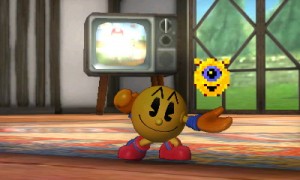
The alien sectors might be overrun with plenty of fearsome creatures like the the many Octys and an evil alien version of Pac-Man, but not Paccet. He starts off the game by declaring “I’m your friend!” and I’m inclined to believe him as he’s a handy guy to have around. Having more Paccets gives protagonists Kissy and Takky a higher chance of obtaining extra shields in the bonus games and they also lend a hand by throwing themselves at bosses. Rest in peace, Paccet. Your sacrifice was for the greater good – my high score.
Alien Sector’s protagonist, Toby “Kissy” Masuyo surprised a lot of players when the game’s ending revealed her gender, much like a certain other alien hunter. So who came first – Kissy or Samus? Well it was Ellen Ripley from Alien, of course!
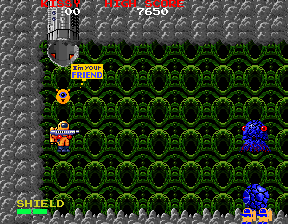
Nintendo equivalent: Baby Metroid (Super Metroid) – It was a friendly alien who sacrificed itself to assist Samus – just like Paccet! Hey, did you know that Alien Sector’s protagonist is the ex-wife of the Dig Dug guy and the mother of Mr. Driller? Namco canon sure is messed up.
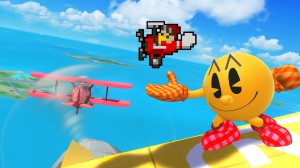
How cute, he thinks he’s in Pilotwings. Silly old Sky Kid. This was another shooting game, but Sky Kid stands out from the rest of Namco’s library with some colourful cartoony graphics and different objectives. The Sky Kids, Red Baron and Blue Max, don’t just shoot down enemy planes; their main mission is to find a bomb and use it to destroy the assigned target. Waiting at the end of each stage are a line of dancing girls who blow kisses if Sky Kid pulls off one of his trademark loop manuvers.
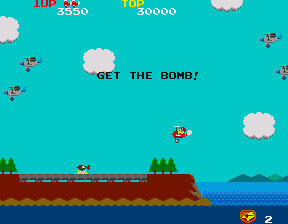
Nintendo equivalent: Falco (Star Fox) – Both are birds that fly planes. Next!
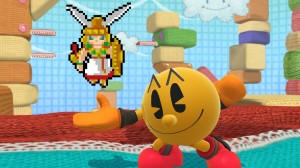
This character actually originated in a game on a Nintendo platform – 1986’s The Adventure of Valkyrie for the Famicom. This Japan-only release was an ambitious action-RPG that is similar to the Legend of Zelda, only not particularly good. But the Valkyrie’s Smash Bros. sprite is taken from the later arcade game, which is actually pretty darn fantastic. Legend of Valkyrie sees players slicing and blasting their way through hoards of enemies as either the Valkyrie or the lizardlike Xandra; funnily enough the arcade game wasn’t initially released in English, but Xandra got a spinoff game where he was renamed “Whirlo” for western audiences. Legend of the Valkyrie was released four years after Sky Kid and it looks significantly nicer. Heaps of enemies appear onscreen at once and there some neat scaling effects where the backgrounds will move to give the illusion of depth. Gold earned from slaying monsters can be spent on new weapons and magic spells, which adds some neat RPG elements to all the fighting and platforming.

Nintendo equivalent: Pit (Kid Icarus) – Both of these heavenly warriors receive orders from a goddess and descend to the earth to beat up fiends with a variety of weapons. They also both turn into an angel when they die despite that not making a whole lot of sense.

Still going strong to this day, Taiko Drum Master is the most recent game to show up in Pac-Man’s taunt. It’s weird that Namco would skip over a decade of their history, but I guess games like Time Crisis and Tekken are more associated with certain consoles and I can’t complain about not having to write another thousand words. Anyway, Taiko Drum Master was released at the height of the arcade rhythm game boom following the popularity of Beatmania and Dance Dance Revolution.
The continued success of the game is partially due its simplicity. There are really only two types of beats to hit, which are performed by banging on the drum or tapping the side. This makes Taiko Drum Master more accessible than Konami’s offerings, but on higher difficulty levels it can be quite a workout! The game’s popularity can also be attributed to its collection of cute characters like Don. He’s even playable in the newest arcade version of Mario Kart, which was also developed by Namco-Bandai. Despite the traditional Japanese flavour of the controller itself, a wide range of musical styles are represented in the game; there’s everything from J-Pop to Classical with a few classic Namco tunes thrown in for good measure.
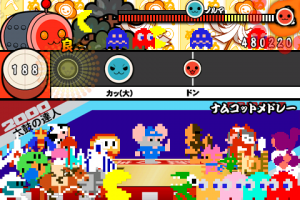
Nintendo equivalent: Donkey Kong – While there was only one English release of the game for the PS2, the Taiko Drum Master series sort of made it overseas in the form of Donkey Konga. Though the peripheral is different, the gameplay is almost the same. Both games even feature Tubthumping!
If you’re curious about these games at all, most of them are playable on modern consoles in some form – I played most of them on the Namco Museum Battle Collection for the PSP. Thank you to The International Arcade Museum for most of the images and you, the reader, for actually getting this far.
